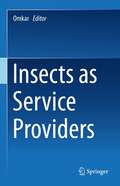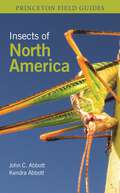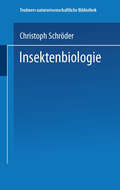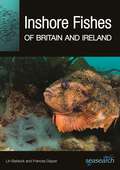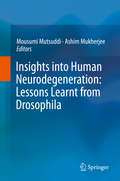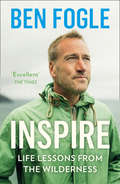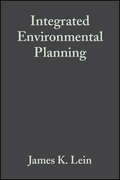- Table View
- List View
Insects and Society
by Timothy D. Schowalter"Insects are the most species-rich and important organisms on earth, and that’s why there are many university courses dedicated to the topic of Insects and Society. But, surprisingly, this is the first textbook specifically created for those courses. The content in this textbook is not only ideal for introductory courses, but it also is great for K12 instructors, insatiably curious children, and indeed anyone fascinated by insects and their impact on people." – Robert K. D. Peterson, Ph.D., Professor of Entomology, Montana State University and Past President, Entomological Society of America "Society is undervaluing the role of insects as pivotal drivers of ecosystem functioning and services. Addressing this deficit is a major merit of this book." – Teja Tscharntke, Professor and Head of the Agroecology Research Group at the University of Göttingen, Germany Insects are all around us, outweighing humanity by 17 times. Many are nuisances; they compete with us for food and carry some of our most devastating diseases. Many common pests have been transported worldwide by humans. Yet, some recent reports suggest dramatic declines in some important groups, such as pollinators and detritivores. Should we care? Yes, we should. Without insect pollinators we’d lose 35% of our global food production; without detritivores, we would be buried in un-decayed refuse. Insects are also critical sources for nutritional, medical and industrial products. A world without insects would seem a very different and unpleasant place. So why do insects inspire such fear and loathing? This concise, full-color text challenges many entrenched perceptions about insect effects on our lives. Beginning with a summary of insect biology and ecology that affect their interactions with other organisms, it goes on to describe the various positive and negative ways in which insects and humans interact. The final chapters describe factors that affect insect abundance and approaches to managing insects that balance their impacts. The first textbook to cater directly to those studying Insect and Society or Insect Ecology modules, this book will also be fascinating reading for anyone interested in learning how insects affect human affairs and in applying more sustainable approaches to "managing" insects. This includes K-12 teachers, undergraduate students, amateur entomologists, conservation practitioners, environmentalists, as well as natural resource managers, land use planners and environmental policy makers.
Insects and Society
by Timothy D. Schowalter"Insects are the most species-rich and important organisms on earth, and that’s why there are many university courses dedicated to the topic of Insects and Society. But, surprisingly, this is the first textbook specifically created for those courses. The content in this textbook is not only ideal for introductory courses, but it also is great for K12 instructors, insatiably curious children, and indeed anyone fascinated by insects and their impact on people." – Robert K. D. Peterson, Ph.D., Professor of Entomology, Montana State University and Past President, Entomological Society of America "Society is undervaluing the role of insects as pivotal drivers of ecosystem functioning and services. Addressing this deficit is a major merit of this book." – Teja Tscharntke, Professor and Head of the Agroecology Research Group at the University of Göttingen, Germany Insects are all around us, outweighing humanity by 17 times. Many are nuisances; they compete with us for food and carry some of our most devastating diseases. Many common pests have been transported worldwide by humans. Yet, some recent reports suggest dramatic declines in some important groups, such as pollinators and detritivores. Should we care? Yes, we should. Without insect pollinators we’d lose 35% of our global food production; without detritivores, we would be buried in un-decayed refuse. Insects are also critical sources for nutritional, medical and industrial products. A world without insects would seem a very different and unpleasant place. So why do insects inspire such fear and loathing? This concise, full-color text challenges many entrenched perceptions about insect effects on our lives. Beginning with a summary of insect biology and ecology that affect their interactions with other organisms, it goes on to describe the various positive and negative ways in which insects and humans interact. The final chapters describe factors that affect insect abundance and approaches to managing insects that balance their impacts. The first textbook to cater directly to those studying Insect and Society or Insect Ecology modules, this book will also be fascinating reading for anyone interested in learning how insects affect human affairs and in applying more sustainable approaches to "managing" insects. This includes K-12 teachers, undergraduate students, amateur entomologists, conservation practitioners, environmentalists, as well as natural resource managers, land use planners and environmental policy makers.
Insects and Their Beneficial Microbes
by Angela E. DouglasA comprehensive overview of symbiotic relationships between insects and microbesInsects and Their Beneficial Microbes is an authoritative and accessible synthesis of insect associations with beneficial microorganisms. Angela Douglas distills the vast literature in entomology and microbiology, as well as the burgeoning microbiome literature, to explore the full scope of insect-microbial interactions and their applications to real-world problems in agriculture and medicine.Douglas investigates how insects acquire and support their microbial partners, and examines how microorganisms contribute to insect nutrition, the defense against natural enemies, and the detoxification of natural allelochemicals and chemical insecticides. She analyzes how beneficial microbes can be harnessed to solve real-world problems in insect pest management, including strategies to suppress the transmission of viruses and microbial disease agents by mosquitoes and other insects. She also addresses the use of insects as biomedical models for effective microbial therapies treating a range of chronic human diseases, and considers how knowledge of insect-microbial interactions can promote the health of beneficial insects, especially in the context of environmental pollutants and climate change.Insects and Their Beneficial Microbes provides a much-needed conceptual framework for the growing discipline of insect-microbial interactions, and offers a wealth of insights into insect symbioses from molecular, physiological, ecological, and evolutionary perspectives.
Insects and Wildlife: Arthropods and their Relationships with Wild Vertebrate Animals
by Dr John CapineraInsects and Wildlife: Arthropods and their Relationships with Wild Vertebrate Animals provides a comprehensive overview of the interrelationships of insects and wildlife. It serves as an introduction to insects and other arthropods for wildlife management and other vertebrate biology students, and emphasizes the importance of insects to wild vertebrate animals. The book emphasizes how insects exert important influences on wildlife habitat suitability and wildlife population sustainability, including their direct and indirect effects on wildlife health. Among the important topics covered are: the importance of insects as food items for vertebrate animals; the role of arthropods as determinants of ecosystem health and productivity; the ability of arthropods to transmit disease-causing agents; an overview of representative disease-causing agents transmitted by arthropods; arthropods as pests and parasites of vertebrates; the hazards to wildlife associated with using using pesticides to protect against insect damage; insect management using techniques other than pesticides; the importance of insect conservation and how insects influence wildlife conservation.
Insects and Wildlife: Arthropods and their Relationships with Wild Vertebrate Animals
by Dr John CapineraInsects and Wildlife: Arthropods and their Relationships with Wild Vertebrate Animals provides a comprehensive overview of the interrelationships of insects and wildlife. It serves as an introduction to insects and other arthropods for wildlife management and other vertebrate biology students, and emphasizes the importance of insects to wild vertebrate animals. The book emphasizes how insects exert important influences on wildlife habitat suitability and wildlife population sustainability, including their direct and indirect effects on wildlife health. Among the important topics covered are: the importance of insects as food items for vertebrate animals; the role of arthropods as determinants of ecosystem health and productivity; the ability of arthropods to transmit disease-causing agents; an overview of representative disease-causing agents transmitted by arthropods; arthropods as pests and parasites of vertebrates; the hazards to wildlife associated with using using pesticides to protect against insect damage; insect management using techniques other than pesticides; the importance of insect conservation and how insects influence wildlife conservation.
Insects as Animal Feed: Novel Ingredients for Use in Pet, Aquaculture and Livestock Diets
by Amanda Beard Hanna Bjone Angela Booth John Brameld Syrine Chaalala Faki Chabi Olivia Champion Chistophe Chrysostome William Clark Victor Clottey Kalifa Coulibaly Emilie Devic Michael Dickinson David Drew Virginia Emery Norbert Erokotan Thomas Farrugia Mark Finke Mohamed Gastli Adin Y. Bloukounon-Goubalan Kerensa Hawkey Antoine Hubert Marc Kenis Gabriel Koko Liz Koutsos Lars-Henrik Lau Heckmann Sean Mason Helen Massey O'Neill James McCulloch Daniel Murta Judith Nelson Emmanuel Nkegbe Noel Obognon Dennis Oonincx Tim Parr Rajmond Percze Sètchémè Pomalégni Liz Quigley Santos Rojo Birgit Rumpold Aliou Saïdou Andrew Salter Istvan Sandor Fernand Sankara Katharina Unger Maureen Wakefield Luke Wheat Keiran WhitakerThe global drive towards sustainability and improved animal health means there is a greater need for development of novel functional ingredients for the feed industry. As the requirements for protein for livestock feed and human consumption grows, the use of insect products as animal feed has gained increasing attention. Covering global production systems of insect protein, oil and chitin, as well as co-products from this industry, this book: - Considers in-depth nutritional and safety aspects of insects for feed. - Reviews suitability of insects as feed for different animal species and life stages. - Examines current knowledge of the value of insect-rearing residues as biofertilizers for crop health. - Identifies the challenges related to regulation, legislation, consumer perception and acceptance, and commercialization of insects. - Provides interviews with established and early-stage innovative companies producing insect protein for feed. Including a focus on practices such as waste valorization, this book takes a holistic look at how insects could contribute to the sustainability of livestock production on a global scale. Providing an up-to-date reference for research scientists, nutritionists, and veterinarians, as well as prospective insect farmers, it will also be of interest to those with a broader curiosity towards climate change, sustainability, and the circular economy.
Insects as Natural Enemies: A Practical Perspective
by Mark A. JervisOver the past three decades there has been a dramatic increase in theoretical and practical studies on insect natural enemies. This considerably updated and expanded version of a previous best-seller is an account of major aspects of the biology of predators and parasitoids, punctuated with information and advice on which experiments or observations to conduct, and how to carry them out. It emphasizes practicalities and also provides guidance on further literature.
Insects as Service Providers
by OmkarThis book overviews the role of insects in providing various human, environmental, recreational, aesthetic, and cultural services. It presents a comprehensive account of insect service providers to show different aspects of insects and cultivate the appreciation of insects.Insects are beneficial to humans as ecofriendly tools, as parasitoids and predators in the biological control of insect pests and vectors, reducing the use of agrochemicals in modern agriculture and protecting the environment. Insects facilitate crop pollination and increase the agricultural yield. They are farmers’ friends, and serve as food for the human population worldwide, provide pharmaceuticals, take part in ecosystem services, and work as scavengers. Insects are used in disease therapy and wound healing. They are also helpful in criminal investigations and are the best models for research and technology innovations. Insects also yield various silks, lac, honey, propolis, wax, etc., promoting insect tourism, recreations, and culture. This contributed volume focuses on these different beneficial aspects of insects in human life. This book will be of interest to undergraduate and postgraduate students of entomology, agricultural zoology, researchers, and anyone interested in insects, including policy planners.
Insects, Fire and Conservation
by Tim R. NewA global synthesis of the impacts of wildfires and controlled burning on insects, bringing together much hitherto scattered information to provide a guide to improved conservation management practice. The great variety of responses by insect species and assemblages demonstrates the often subtle balance between fire being a severe threat and a vital management component. Examples from many parts of the world and from diverse biotopes and production systems display the increasingly detailed appreciation of fire impacts on insects in terrestrial and freshwater environments and the ways in which prescribed burning may be tailored to reduce harmful ecological impacts and incorporated into protocols for threatened species and wider insect conservation benefits.
Insects of Ireland: An Illustrated Introduction Ireland's Butterflies, Ladybirds, Shieldbugs, Ants And Other Groups
by Stephen McCormack Eugenie Regan Chris ShieldsOver 11,000 species of insects occur in Ireland but most are very small and escape notice. Identifying them accurately can be difficult or impossible. This comprehensive compact guide to over 120 of Ireland’s most popular insects includes all Irish species of butterflies, bumblebees, dragonflies, ladybirds, grasshoppers and shield bugs. All are illustrated in colour with clear descriptions enabling accurate identification.
Insects of North America (Princeton Field Guides #157)
by Dr. John C. Abbott Kendra K. AbbottThe ultimate photographic field guide to North American insectsThis amazing field guide enables you to identify all 783 families of insects currently recognized in the United States and Canada. Richly illustrated with more than 3,700 stunning photos along with keys to families for many of the orders, Insects of North America features a comprehensive introduction that discusses classification and nomenclature, insect diversity, global threats, the latest collecting and curatorial techniques, and the many ways these remarkable organisms impact society. Combined with in-depth taxonomic coverage, this is the essential resource for both professionals and amateurs interested in the most diverse group of animals on the planet.Covers all 783 insect families known to occur in the United States and CanadaFeatures more than 3,700 color photos, with nearly every photo identified to species levelIncludes an illustrated glossary for easy reference in the fieldThe first field companion of its kind since the publication of the Peterson guide in 1970Ideal for entomology courses of all levelsAn invaluable resource for anyone interested in insects
Insects: A Very Short Introduction (Very Short Introductions #1)
by Simon LeatherTo date, more than a million insect species have been described, with probably at least another 5-8 million species waiting in the wings for a name. Insects are a fascinatingly diverse and beautiful spectrum of animals. They range in size from the tiny parasitic wasp, measuring a mere 139µm, to the aptly named Titan beetle, which can reach lengths of up to 17cm. They can be found on all continents of the world, from the Sahara Desert to the frozen wastes of Antarctica; in caves, under the ground, inside plants, other insects and vertebrates, in rivers, streams, lakes and ponds, in puddles, in the watery interiors of pitcher plants; and in our houses. While no insects live beneath the waves, the intrepid sea skaters skim the surface of some of the world's oceans. This Very Short Introduction explores the extraordinary world of insects. It analyses insect evolution, taxonomy and development, and describes their behaviour, their life styles, and the interactions they have with other insects and other animals. As Simon Leather shows, insects are the bedrock on which human civilisation rests; without them we would almost certainly not exist. Although they can be seen as pests of our crops plants, they are also invaluable for pollinating our flowering plants and are an invaluable link in all land ecosystems. As they face challenges from climate change and pesticides it has never been more important to understand these oft-dismissed creatures. Very Short Introductions: Brilliant, Sharp, Inspiring ABOUT THE SERIES: The Very Short Introductions series from Oxford University Press contains hundreds of titles in almost every subject area. These pocket-sized books are the perfect way to get ahead in a new subject quickly. Our expert authors combine facts, analysis, perspective, new ideas, and enthusiasm to make interesting and challenging topics highly readable.
Insects: A Very Short Introduction (Very Short Introductions)
by Simon LeatherTo date, more than a million insect species have been described, with probably at least another 5-8 million species waiting in the wings for a name. Insects are a fascinatingly diverse and beautiful spectrum of animals. They range in size from the tiny parasitic wasp, measuring a mere 139µm, to the aptly named Titan beetle, which can reach lengths of up to 17cm. They can be found on all continents of the world, from the Sahara Desert to the frozen wastes of Antarctica; in caves, under the ground, inside plants, other insects and vertebrates, in rivers, streams, lakes and ponds, in puddles, in the watery interiors of pitcher plants; and in our houses. While no insects live beneath the waves, the intrepid sea skaters skim the surface of some of the world's oceans. This Very Short Introduction explores the extraordinary world of insects. It analyses insect evolution, taxonomy and development, and describes their behaviour, their life styles, and the interactions they have with other insects and other animals. As Simon Leather shows, insects are the bedrock on which human civilisation rests; without them we would almost certainly not exist. Although they can be seen as pests of our crops plants, they are also invaluable for pollinating our flowering plants and are an invaluable link in all land ecosystems. As they face challenges from climate change and pesticides it has never been more important to understand these oft-dismissed creatures. Very Short Introductions: Brilliant, Sharp, Inspiring ABOUT THE SERIES: The Very Short Introductions series from Oxford University Press contains hundreds of titles in almost every subject area. These pocket-sized books are the perfect way to get ahead in a new subject quickly. Our expert authors combine facts, analysis, perspective, new ideas, and enthusiasm to make interesting and challenging topics highly readable.
Insekten - Erfolgsmodelle der Evolution: Faszinierend und bedroht
by Werner Gnatzy Jürgen TautzIm Laufe der Evolution haben die Insekten eine schier unglaubliche Formenvielfalt und funktionelle Raffinesse entwickelt. Das Design ihres Außenskeletts ist so phantasievoll und ungewöhnlich, oft auch bizarr, dass man nur staunen kann. Dass Insekten für jedes noch so spezielle Problem Konstruktionslösungen finden können, macht sie überaus erfolgreich. Sie wurden so zu entscheidenden Bindegliedern in den komplexen Netzwerken der Natur. Beindruckende Makroaufnahmen und informative rasterelektronenoptische Bilder geben einen Einblick in Formenreichtum, Schönheit und Funktion der Sechsbeiner. Spannende Texte begleiten die Bilder und erklären u.a. wie der Gelbrandkäfer Wirbeltierhormone als K.O.-Tropfen einsetzt, wenn er von Fischen angegriffen wird, der Kiefernprachtkäfer weit entfernte Waldbrände lokalisiert, der Bombardierkäfer mit seinem Schussapparat gepulste Explosionen abgibt oder die Bläulingsraupe Ameisen bezirzt. In den Ökosystemen unseres Planeten spielen die Insekten eine entscheidende Rolle. Die menschengemachte Umweltzerstörung greift empfindlich in diese Kreisläufe ein. Das gefährdet das Überleben der Insekten, mit dramatischen Auswirkungen auch für uns Menschen.
Insektenbiologie (Teubners naturwissenschaftliche Bibliothek)
by Christoph SchröderDieser Buchtitel ist Teil des Digitalisierungsprojekts Springer Book Archives mit Publikationen, die seit den Anfängen des Verlags von 1842 erschienen sind. Der Verlag stellt mit diesem Archiv Quellen für die historische wie auch die disziplingeschichtliche Forschung zur Verfügung, die jeweils im historischen Kontext betrachtet werden müssen. Dieser Titel erschien in der Zeit vor 1945 und wird daher in seiner zeittypischen politisch-ideologischen Ausrichtung vom Verlag nicht beworben.
Insektenwunderwelt - Einstieg in die Entomologie
by Michael SchmittSie interessieren sich für Insekten, aber die Lehrbücher der Entomologie sind Ihnen zu dick, zu teuer und zu kompliziert? Dieses Buch lässt Sie vieles über die faszinierende Vielfalt der Insekten erfahren.Es gibt Insekten wie Sand am Meer, große und kleine, schöne und hässliche, erfreuliche und lästige, nützliche und schädliche. Einige, wie die Küchenschaben, lösen Ekel aus, andere, wie die Siebenpunkt-Marienkäfer gelten als Glückssymbole, wieder andere, wie die Wespen, ängstigen uns, während die meisten Schmetterlinge wegen ihrer Farben- und Formenpracht bewundert werden. Was aber Insekten befähigt, zu laufen, zu springen, zu fliegen, wozu sie Menschenblut benötigen, wie aus einem Ei ein vollständiger Sechsbeiner wird, welchen Stellenwert Insekten im Haushalt der Natur einnehmen, erschließt sich nicht unmittelbar durch Beobachten lebender Tiere. Neben dem äußeren Erscheinungsbild werden der Körperbau und Funktionen der Organe ebenso wie Verhalten, ökologische Rolle, natürliches System und Stammesgeschichte der Insekten allgemeinverständlich und doch wissenschaftlich exakt dargestellt.
Inshore Fishes of Britain and Ireland (Wild Nature Press #33)
by Lin Baldock Frances DipperA beautifully illustrated photographic identification guide to the common marine fish found around Britain and Ireland—ideal for divers, snorkellers, and natural history enthusiastsFish are a colourful and important part of inshore marine life, much admired by divers and snorkellers. But it can be difficult to accurately identify and record these quick-moving animals underwater. This authoritative, beautifully illustrated photographic guide offers a practical, easy-to-use approach for identifying the fish species commonly seen in the waters around Britain and Ireland, as well as a few vagrant and interesting rare species. The book’s concise text explains how fish can be identified underwater, and is accompanied by numerous photographs of each species in its natural environment and diagrams illustrating key features. The book also clearly indicates the cases when underwater species identification is more difficult. Published in association with the UK’s Marine Conservation Society, the book makes an invaluable addition to the series of marine photographic titles of Seasearch, a species recording project for volunteer sports divers.Features individual descriptions of more than 150 species, with information on size, depth range, habitat and distribution in the Seasearch guide icon formatIllustrates every species in its natural underwater environmentEmphasises key identification features and possible confusion speciesIncludes a “confidence guide” distinguishing between easily recognisable species and those requiring closer examinationFeatures longer sections highlighting interesting species, behaviours and other topicsProvides information on protected species, taxonomy, shifting distributions and conservation status
Inside Nature’s Giants
by David DuganWith a foreword by Richard Dawkins, and based on the BAFTA award-winning Channel 4 TV series, Inside Nature’s Giants gets under the skin of the largest animals on the planet. See them as you've never seen them before – from the inside out.
Insight into Influenza Viruses of Animals and Humans
by Sanjay Kapoor Kuldeep DhamaThis book provides salient information on all aspects of influenza/flu viruses affecting animals and humans. It specifically reviews the properties and replication of influenza viruses; their evolution and emergence; epidemiology; role of migratory birds in disease transmission; clinical signs in humans, animals and poultry; pathogenesis and pathogenicity; public health importance and potential threats; diagnosis; prevention and control measures; and pandemic preparedness. Influenza/flu viruses evolve continuously and jump species causing epidemics as well as pandemics in both human and animals. During the past 150 years, various strains of influenza virus like the Spanish flu, Asian flu, Hong Kong flu, bird flu and swine flu were responsible for high mortality in humans as well as birds. High mutation rates, antigenic shifts, drifts, reassortment phenomena, and the development of antiviral drug resistance all contribute to ineffective chemotherapy and vaccines against influenza viruses. Due to their devastating nature, high zoonotic implications and high mortality in humans and poultry, they have a severe impact on the socioeconomic status of countries. Disease awareness, rapid and accurate diagnosis, surveillance, strict biosecurity, timely adoption of appropriate preventive and control measures and pandemic preparedness are crucial to help reduce virus transmission, thus reducing clinical cases, deaths and pandemic threats.
Insights from Comparative Hearing Research (Springer Handbook of Auditory Research #49)
by Christine Köppl Geoffrey A. Manley Arthur N. Popper Richard R. FayThe hearing organs of non-mammals, which show quite large and systematic differences to each other and to those of mammals, provide an invaluable basis for comparisons of structure and function. By taking advantage of the vast diversity of possible study organisms provided by the "library" that is biological diversity, it is possible to learn how complex functions are realized in the inner ear through the evolution of specific structural, cellular and molecular configurations. Insights from Comparative Hearing Research brings together some of the most exciting comparative research on hearing and shows how this work has profoundly impacted our understanding of hearing in all vertebrates.
Insights into Human Neurodegeneration: Lessons Learnt from Drosophila
by Mousumi Mutsuddi Ashim MukherjeeThis book is aimed at generating an updated reservoir of scientific endeavors undertaken to unravel the complicated yet intriguing topic of neurodegeneration. Scientists from Europe, USA and India who are experts in the field of neurodegenerative diseases have contributed to this book. This book will help readers gain insight into the recent knowledge obtained from Drosophila model, in understanding the molecular mechanisms underlying neurodegenerative disorders and also unravel novel scopes for therapeutic interventions. Different methodologies available to create humanized fly models that faithfully reflects the pathogenicities associated with particular disorders have been described here. It also includes information on the exciting area of neural stem cells. A brief discussion on neurofibrillary tangles, precedes the elaborate description of lessons learnt from Drosophila about Alzheimer's, Parkinson’s, Spinomuscular Atrophy, Huntington’s diseases, RNA expansion disorders and Hereditary Spastic Paraplegia. We have concluded the book with the use of Drosophila for identifying pharmacological therapies for neurodegenerative disorders. The wide range of topics covered here will not only be relevant for beginners who are new to the concept of the extensive utility of Drosophila as a model to study human disorders; but will also be an important contribution to the scientific community, with an insight into the paradigm shift in our understanding of neurodegenerative disorders. Completed with informative tables and communicative illustrations this book will keep the readers glued and intrigued. We have comprehensively anthologized the lessons learnt on neurodegeneration from Drosophila and have thus provided an insight into the multidimensional aspects of pathogenicities of majority of the neurodegenerative disorders.
Inspire: Life Lessons From The Wilderness
by Ben FogleThe latest adventure from bestselling author Ben Fogle explores what we can learn from nature about living well and living wild.
The Instant
by Amy Liptrot'I loved this book' Raynor Winn, author of The Salt Path 'Utterly absorbing' Lucy Jones, author of Losing Eden Wishing to leave behind the quiet isolation of her Orkney island life, Amy Liptrot books a one-way flight to Berlin. Searching for new experiences, inspiration and love, she rents a loftbed in a shared flat and looks for work. She explores the streets, nightclubs and parks and seeks out the city’s wildlife – goshawks, raccoons and hooded crows. She looks for love through the screen of her laptop. Over the course of a year Amy makes space hoping for the unexpected. And it comes with an erotic jolt, in the form of a love affair that obsesses her. The Instant is an unapologetic look at the addictive power of love and lust. It is also an exploration of the cycles of the moon, the flight paths of migratory birds, the mesmerising power of Neolithic stonework and the trails followed by a generation who exist online.
Integrated Environmental Planning
by James K. LeinThis up-to-date and comprehensive reference presents the fundamentals of environmental planning, incorporating theory, practice and case studies. The book includes balanced coverage and real world examples to illustrate the concepts. Political, ethical, and societal considerations are all addressed. Presents the fundamentals of environmental planning and methodological material for analysis. Real world examples are provided to illustrate concepts. Political, ethical and societal considerations are addressed. Coverage is balanced between theoretical and practical.
Integrated Fish Farming
by Jack A. Mathias Charles AnthonyIf you are looking for wide-ranging international coverage of all aspects of integrated fish forming, this is the book you need. With a carefully selected and fully interdisciplinary collection of papers from experts around the world, Integrated Fish Farming provides thorough, detailed coverage of one of the world's most important approaches to integrated farming systems. Integrated Fish Fanning places IFF in a global context, reporting on case studies of successful IFF operations, experiments to enhance IFF performance, bioeconomic survey and modeling analyses, research on farm waste use and pond ecology, socio-economic elements of IFF extension and adoption, and the bio-technical and economic aspects of adapting IFF to reservoirs, marshlands, rice paddies, and marginal habitats. With contributions from leading international authorities and in-depth information from IFF operations worldwide, this is the definitive reference on Integrated Fish Farming.





